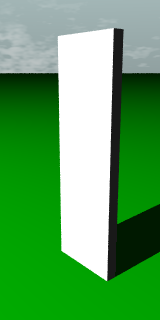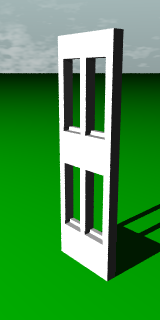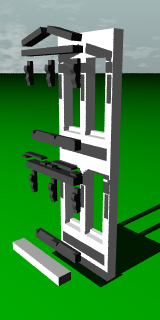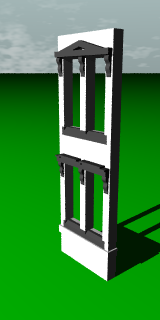Virtual 1221 -- how it's constructed
Measuring the Building
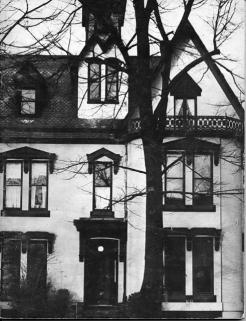 The
first problem was (and still is) to determine the building plan
and dimensions. I began with the picture on the cover of the 1963
yearbook, which shows the the front of the school viewed almost
perpendicularly from across Massachusetts Avenue. This photograph
by Howie Mitchell (or Grayson Mattingly?) is so clear that it is possible to count
the courses of bricks -- though probably not on the smaller version
shown at left. So I counted the bricks to determine that
the parlor bay window openings are 40 courses tall, the sills are five courses,
and so on.
The
first problem was (and still is) to determine the building plan
and dimensions. I began with the picture on the cover of the 1963
yearbook, which shows the the front of the school viewed almost
perpendicularly from across Massachusetts Avenue. This photograph
by Howie Mitchell (or Grayson Mattingly?) is so clear that it is possible to count
the courses of bricks -- though probably not on the smaller version
shown at left. So I counted the bricks to determine that
the parlor bay window openings are 40 courses tall, the sills are five courses,
and so on.
The picture was taken with the camera tilted very slightly upward,
but the cameras appears to have been in approximately same plane as the tops of
the basement windows. At the intersection of that plane with the
picture, the horizontal and vertical scales should be the same, so I
deduced that the width of the parlor bay window openings is equal to the height
of 15 courses of bricks.
Sandy and Eleanor still have a few
bricks from 1221, but these are special decorative red bricks which are
not representative of the yellow pressed brick used in the front part
of the building. Fortunately, the dimensions of pressed brick
(unlike common brick) were highly standardized: 8 3/8 x 4 1/8 x 2 3/8 inches. Because pressed brick was very smooth and uniform, mortar joint dimensions of 1/8 to 3/16 inches were typically used, and I think the mortar at 1221 was close to 1/8.
This means that the height of one brick plus one course of mortar would
have been 2.5 inches, so for example the window openings would have
been 40 * 2.5 = 100 inches, or 8 feet 4 inches high, and 15 * 2.5 =
37.5 inches wide.
The total width of the front facade (not including OSH) in the
"Virtual 1221" model is about 43 feet; this compares favorably with the
width read out from Sanborn insurance maps, which ranges from 40 to 46
feet in various editions.
Building a Wall
Armed with a few dimensions and some guesswork, I've begun to model the
building. The model is built up in
POV-Ray from simple geometric
shapes such as rectangular boxes, cylinders, and spheres, with
limited use of more complex shapes defined by quadratic splines
(polynomials which can form more or less arbitrary curves).
The first step is simply to define a box which represents a section of
wall (in this case, the south wall of the parlor bay), ignoring details
such as window openings, lintels, and sills.
Next, the window openings are subtracted from the wall volume.
The openings have some extra space removed to accomodate the sill --
this wouldn't be necessary except that some of the sills have a bevel,
and the wall would show through in that area.
The sills are just blocks with an inclined box subtracted to make the
bevel. The lintels are more complex -- the model doesn't yet
really do them justice -- and are built up out of a number of
overlapping boxes, some of which are tilted, as shown in the exploded
view above. Until recently I hadn't found a good picture of the
lintel brackets, so I'm still using a rough approximation. These
are made from a quadratic spline curve fitted by hand.
Finally, all the decorations -- lintels, sills, and raised band course,
are assembled and added to the wall. In some cases, such as the
OSH corners, the wall then needs to be rotated or translated (moved)
into its final position.
Photogrammetry
Photogrammetry is a method used to find the relative dimensions and
orientation of objects from photographic views. It relies
primarily on the inversion of geometrical perspective to obtain the
size and shape of the original object. Ideally, the
photographs are taken with calibrated cameras at a known distance and
direction from the building, but of course that is not possible with
1221. Recently, new techniques have been developed which allow
the use of uncalibrated photographs, but it is still necessary to have
some known dimension (in this case, the pressed bricks) and to have
photographs taken from many different angles. To further correct
and complete the Virtual 1221 model, I am in the process of learning
more about photogrammetry.
-- Dana Sawyer
Copyright © 2004-2006 by Dana Sawyer
This page last updated May 21, 2006
 The
first problem was (and still is) to determine the building plan
and dimensions. I began with the picture on the cover of the 1963
yearbook, which shows the the front of the school viewed almost
perpendicularly from across Massachusetts Avenue. This photograph
by Howie Mitchell (or Grayson Mattingly?) is so clear that it is possible to count
the courses of bricks -- though probably not on the smaller version
shown at left. So I counted the bricks to determine that
the parlor bay window openings are 40 courses tall, the sills are five courses,
and so on.
The
first problem was (and still is) to determine the building plan
and dimensions. I began with the picture on the cover of the 1963
yearbook, which shows the the front of the school viewed almost
perpendicularly from across Massachusetts Avenue. This photograph
by Howie Mitchell (or Grayson Mattingly?) is so clear that it is possible to count
the courses of bricks -- though probably not on the smaller version
shown at left. So I counted the bricks to determine that
the parlor bay window openings are 40 courses tall, the sills are five courses,
and so on.